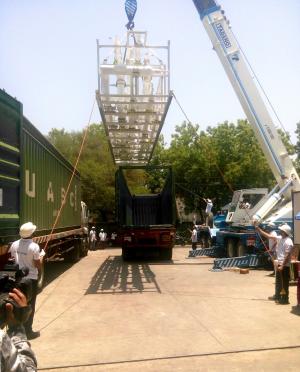First batch of cryolines en route from India
12 Jun 2017
-
Dilshad Sulaiman, ITER India
Over five kilometres of cryolines (5.5 km) will be necessary to deliver cryogenic cooling power to the main "clients" in the Tokamak Building—the ITER magnets (45 percent), the thermal shield (40 percent), and the cryopumps (15 percent). During operation, nearly 25 tonnes of liquid helium at minus 269 °C will circulate throughout the ITER installation.
One of the three open-topped containers used to transport the first batch of cryolines from India. Cryolines are part of the important cryodistribution network that will bring cooling power produced in the on-site cryoplant to "clients" in the Tokamak Building.
The ITER cryolines are a system of complex, multi-process, vacuum-insulated lines ranging from one to eight process pipes that will connect cryogenic components in the Tokamak Building to the cryoplant, where the required cooling power will be produced.
The cryolines form part of the ITER cryodistribution system, which also comprises forced flow cold boxes, pumps, valves and manifolds.
Under the responsibility of the Indian Domestic Agency the procurement of the cryolines has reached an important milestone. The first batch—nitrogen lines and relief lines totaling about 350 metres in length—has been produced and shipped in three 12-metre open-top containers. Special metallic frames were designed to ensure the secure transport of these items over sea and road.
On 17 May, a flag-off ceremony was held in Kalol at the supplier Inox India Limited in the presence of personnel from ITER India.
The three containers are travelling on board the CMA CGM TOSCA that departed from the Jawaharlal Nehru Port near Mumbai on 3 June.
The three containers are travelling on board the CMA CGM TOSCA that departed from the Jawaharlal Nehru Port near Mumbai on 3 June.
Other cryolines batches will be shipped in a similar manner over the next 18 months.


